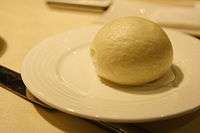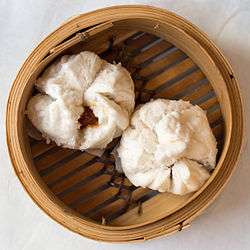Baozi
|
meat baozi for sale on a market | |
| Alternative names | Bao, humbow, nunu, pau |
|---|---|
| Type | Filled steamed bread |
| Place of origin | China |
| Creator | [[]] |
| Variations | Dabao, xiaobao |
|
| |
| Baozi | |||||||||||||||
| Chinese | 包子 | ||||||||||||||
|---|---|---|---|---|---|---|---|---|---|---|---|---|---|---|---|
| |||||||||||||||
A baozi (Chinese: ![]() 包子) or simply known as bao, bau, humbow, nunu, bakpao (Hokkien), bausak, pow, pau or pao (Hakka) is a type of steamed, filled, bun[1] or bread-like (i.e. made with yeast) item in various Chinese cuisines, as there is much variation as to the fillings and the preparations. In its bun-like aspect it is very similar to the traditional Chinese mantou. It can be filled with meat and/or vegetarian fillings.
包子) or simply known as bao, bau, humbow, nunu, bakpao (Hokkien), bausak, pow, pau or pao (Hakka) is a type of steamed, filled, bun[1] or bread-like (i.e. made with yeast) item in various Chinese cuisines, as there is much variation as to the fillings and the preparations. In its bun-like aspect it is very similar to the traditional Chinese mantou. It can be filled with meat and/or vegetarian fillings.
Two types are found in most parts of China and Indonesia: Dàbāo (大包, "big bun"), measuring about 10 cm across, served individually, and usually purchased for take-away. The other type, Xiǎobāo (小包, "small bun"), measure approximately 5 cm wide, and are most commonly eaten in restaurants, but may also be purchased for take-away. Each order consists of a steamer containing between three and ten pieces. A small ceramic dish is provided for vinegar or soy sauce, both of which are available in bottles at the table, along with various types of chili and garlic pastes, oils or infusions, fresh coriander and leeks, sesame oil, MSG, and other flavorings.
History
According to legend, they were invented by the Chinese scholar and military strategist Zhuge Liang during the Three Kingdoms period (3rd century AD).[2] An alternate theory is that Mongols brought the form to China in the Yuan Dynasty from the Turkic court.
Types



| English name | Chinese name Simplified / Traditional Pinyin |
Other names | Description |
|---|---|---|---|
| Cha siu bao, Charsiu bau | 叉烧包 / 叉燒包 chāshāobāo | manapua | filled with barbecue-flavoured char siu pork; typical of Cantonese cuisine (Guangdong province and Hong Kong) |
| Goubuli baozi | 狗不理包子 gǒubùlǐ bāozi | a well known brand of meat-filled baozi considered characteristic of Tianjin, Northern China; its name literally means, "Baozi ignored by dogs" | |
| Xiaolongbao | 小笼包 / 小籠包 xiǎolóngbāo | a small, meat-filled baozi from Shanghai containing a juicy broth. Because it is succulent and prepared only with thin, partially leavened dough, it is sometimes considered different from other bao types, and more closely resembles a jiaozi (dumpling) | |
| Shengjian mantou | 生煎馒头 / 生煎饅頭 shēngjiān mántou | a small, meat-filled, fried baozi from Shanghai | |
| Tangbaozi | 汤包 / 湯包 tāngbāo | a large soup-filled baozi from Yangzhou drunk through a straw; in other areas of China, it is small in size with rich soup | |
| Doushabao | 豆沙包 dòushābāo | Hokkien: tāu-se-pau | filled with sweet bean paste |
| Lotus seed bun | 莲蓉包 liánróngbāo | filled with sweetened lotus seed paste | |
| Kaya-baozi | filled with Kaya, a popular jam made from coconut, eggs, and sometimes pandan in Malaysia and Singapore | ||
| Naihuangbao | 奶黄包 / 奶黃包 nǎihuángbāo | filled with sweet yellow custard filling | |
| Shāobāo | 烧包 / 燒包 shāobāo | Spanish: siópao; Philippine: siyopaw | steamed, filled with either chicken, pork, shrimp or salted egg |
| Zhimabao | 芝麻包 zhīmabāo | steamed, filled with a black sesame paste | |
| Yacaibao (Beansprout-bao) | 芽菜包 Yácàibāo | steamed, filled with a type of pickle, spices and possibly other vegetables or meat, common in Sichuan, China | |
| Bah-pau | 肉包 ròubāo | Hokkien: Bah-pau | filled with pork |
| Big Pau | 大包 dàbāo | large buns filled with pork, eggs and other ingredients | |
| Baozza | 包萨
bāosà |
well-known brand based in China famous for their fusion baozi, which are steamed and filled with a variety of pizza toppings |
Culture
In many Chinese cultures, these buns are a popular food, and widely available.[1] While they can be eaten at any meal, baozi are often eaten for breakfast. They are also popular as a portable snack or meal.
The dish has also become common place throughout various regions of South East Asia due to longstanding Chinese immigration.
- Due to the long history of Chinese overseas diaspora in Malaysia, the Malays have adopted these buns as their own. A particularly Malay form of the baozi (called pau in Malay) is filled with potato curry, chicken curry or beef curry that are similar to the fillings of Malay curry puffs. Some variants have a quail egg in the middle, in addition to the curry. Due to the Muslim beliefs of most Malays, these buns are halal and contain no pork. One can find Malay stalls selling the buns by the roadside, at pasar malams (night markets), highway rest stops, and pasar Ramadans (Ramadan food bazaars).
- Similarly, in Indonesia the dish has been adopted into Indonesian cuisine through the integration of Chinese culture. It has been adopted through the Hokkien name of "Bakpao". Excluding existing meat filling, local variants include: chocolate, sweet potato, and marmalade filling.
- In the Philippines, their version of Baozi is called Siopao brought by Chinese immigrants (Sangleys) prior to Spanish colonialism. A Filipino siopao filing contains Meatball, Philippine adobo, flaked tuna and pork, and sometimes chocolate and cheese.
- A similar concept is also present in Thailand as they are called salapao.
See also
- Bánh bao, the Vietnamese equivalent
- Buuz, the Mongolian equivalent
- Dampfnudel, the German equivalent
- Empanada
- Jiaozi
- Khinkali
- Kreplach
- List of buns
- List of Chinese dishes
- List of steamed foods
- Manapua, the Hawaiian equivalent
- Mandu, the Korean equivalent
- manty/mantı (Turkic) Turkish, Persian, and Pukhtoon cuisines
- Mantou Chinese steamed bread without filling
- Momo, the Nepalese and Tibetan equivalent
- Nikuman (and Chūkaman), the Japanese variants
- Pao, the Malagasy equivalent
- Pirozhki
- Ravioli
- Wonton
Notes
- 1 2 Phillips, C. (2016). All Under Heaven: Recipes from the 35 Cuisines of China. Ten Speed Press. p. 405. ISBN 978-1-60774-982-0. Retrieved November 5, 2016.
- ↑ See Etymology of "mantou"


